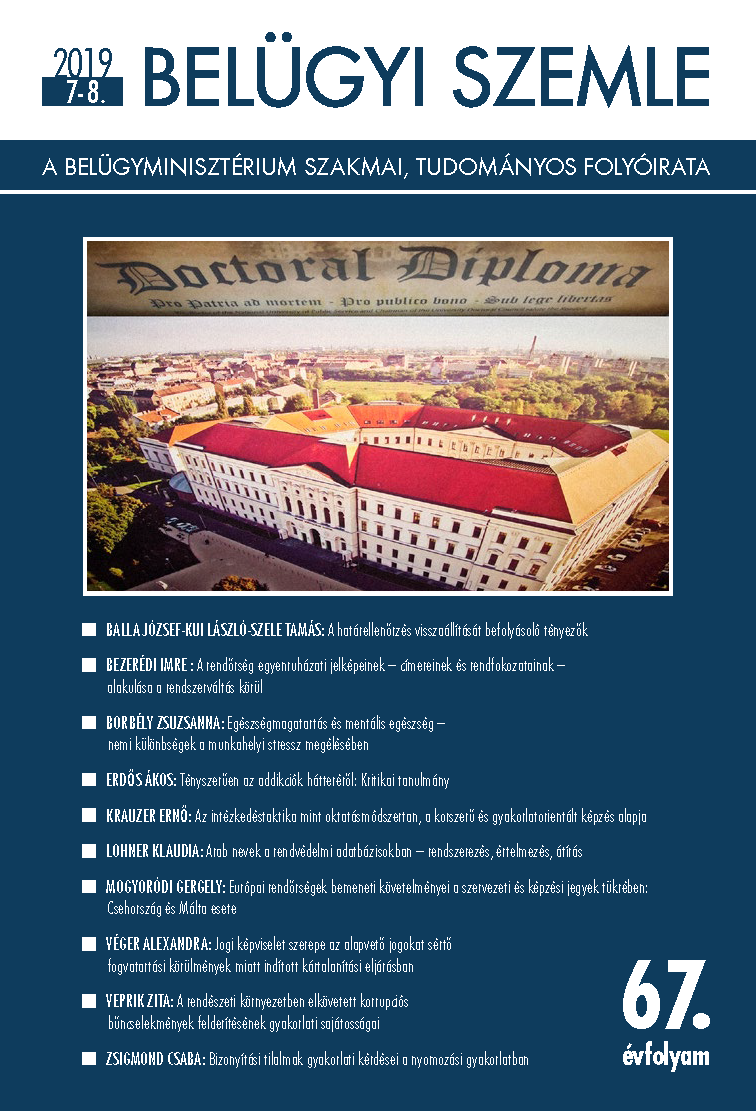Keywords
arabic names
identify
database
migration
identify
database
migration
How to Cite
Arab nevek a rendvédelmi adatbázisokban – rendszerezés, értelmezés, átírás. (2019). Academic Journal of Internal Affairs, 67(7-8), 117-132. https://doi.org/10.38146/BSZ.2019.7-8.6
Abstract
The continuously growing presence of Arabic culture in Europe raises new challenges for Hungary. Diverse variety of law enforcement’s expertise are contained by these challenges. In order to find a proper solution to these challenges of immigration, it is necessity for the law enforcement agencies to get familiar with the Arabic culture and their way of thinking, understand the structure of Arabic names; moreover, we have to get to know the problematic situation of the transcription of Arabic names. All these are essential for the highest level of efficiency at law enforcement agencies.
Downloads
Download data is not yet available.
Similar Articles
- Zsuzsanna Hornyik, Establishment of the National Directorate-General for Aliens Policing , Academic Journal of Internal Affairs: Vol. 68 No. 9 (2020)
- Gyula Csege, Security control in migration , Academic Journal of Internal Affairs: Vol. 64 No. 1 (2016)
- Béla Szilágyi, Refugee Camp: A Tool for Dignity and Security , Academic Journal of Internal Affairs: Vol. 69 No. 4. ksz. (2021): Különszám
- Gábor Péter, Róbert Sinkovics, Illegal immigration in the activities of the Zala county police department , Academic Journal of Internal Affairs: Vol. 64 No. 12 (2016)
- Lászlóné Hazai, Methods, techniques in biometric facial recognition and identification , Academic Journal of Internal Affairs: Vol. 67 No. 1 (2019)
- Krisztina Zán Görbe Attiláné, Gábor Éberhardt, Xenophobia research results and recommendations in Hungary among those responsible for the management of human migration , Academic Journal of Internal Affairs: Vol. 69 No. 6 (2021)
- Gyula Csege, Crime and control in the field of immigration , Academic Journal of Internal Affairs: Vol. 65 No. 3 (2017)
- Horolma Pamzsav, An additional result of population genetics: genetical origin-of-life research , Academic Journal of Internal Affairs: Vol. 67 No. 11 (2019)
- Csaba Csányi, Terrorism and organized crime: profit or ideology? , Academic Journal of Internal Affairs: Vol. 66 No. 2 (2018)
- Zoltán Merkl, The role and tasks of law enforcement authorities in the ‘external’ protection of the state , Academic Journal of Internal Affairs: Vol. 70 No. 4 (2022)
You may also start an advanced similarity search for this article.
Most read articles by the same author(s)
- Klaudia Lohner, Special Investigative Support and Behavioural Analysis , Academic Journal of Internal Affairs: Vol. 72 No. 5 (2024)
- Klaudia Lohner, Criminal profiling – trough researches to crime scene investigation , Academic Journal of Internal Affairs: Vol. 69 No. 12 (2021)
- Klaudia Lohner, Zsombor Hermann, József Haller, Traces of sexual motivation at the crime scene: from criminal psychology to forensics , Academic Journal of Internal Affairs: Vol. 69 No. 10 (2021)
- Tamás Keszi, Klaudia Lohner, Theory and policing practice of network analysis , Academic Journal of Internal Affairs: Vol. 70 No. 1 (2022)
- Éva Rompos, Noémi Emőke Baráth, Zsóka Mária Bellavics, Klaudia Lohner, József Haller, The law enforcement neurobiology of the „bika” (bull) drug , Academic Journal of Internal Affairs: Vol. 69 No. 4 (2021)
- Klaudia Lohner, István Csomós, Risk analysis of potential terrorist offenders , Academic Journal of Internal Affairs: Vol. 70 No. 9 (2022)
